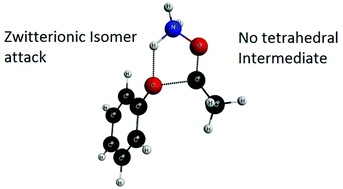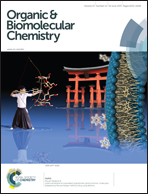The role of ammonia oxide in the reaction of hydroxylamine with carboxylic esters†
Abstract
Theoretical calculations indicate that hydroxylamine can exist in both neutral and zwitterionic (ammonia oxide) forms in aqueous solution, the former being 3.5 kcal mol−1 more stable. In this report, we have studied the reaction mechanism of hydroxylamine with phenyl acetate and analyzed the role of the zwitterionic isomer. We have observed that the main reaction pathway takes place through the zwitterionic form with a concerted mechanism, not involving the classical tetrahedral intermediate. Attack by the nitrogen atom (via neutral isomer) has a minor contribution and it is also a concerted process. The activation free energy barriers in aqueous solution were calculated at the MP4/TZVPP + diff level for gas phase energies, CPCM for optimization and frequencies, and through single point calculation of the solvation free energy using the SM8 method. Our theoretically predicted barriers are 20.8 and 23.8 kcal mol−1 for O and N attack, respectively, in very good agreement with the experimental values of 20.4 and 22.3 kcal mol−1, respectively. Our results support the view that hydroxylamine is a very special nucleophile and the reactivity of this functional group should be further investigated.


 Please wait while we load your content...
Please wait while we load your content...